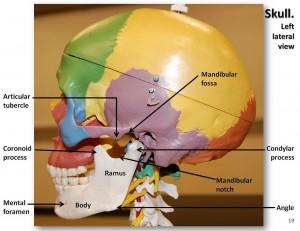What is TMJ?
 The temporomandibular joint, or often called as TMJ, is the joint of the jaw. We have two temporomandibular joints that work in unison, one on the either side of the jaw. It got its name because of the temporal bone and the mandible that forms the joint.
The temporomandibular joint, or often called as TMJ, is the joint of the jaw. We have two temporomandibular joints that work in unison, one on the either side of the jaw. It got its name because of the temporal bone and the mandible that forms the joint.
It is the most used joint in our body. It has 6 main components and they are the mandibular condyles, the capsule, the articular surface to the temporal bone, the articular disc, lateral pterygoid and the ligaments.
What is TMJ Dysfunction?
This condition is common and affects over 10 million Americans today. It is affecting the mastication muscles and the tissue components. It can be a medical or a dental condition or a collection of conditions.
What are the causes ?
There are different factors that can influence the inflammation of the Temporomandibular joints such as teeth grinding, a direct physical trauma that causes disc derangement, stress, hypermobility of the joint, hypomobility of the joint, osteoarthritis, rheumatoid arthritis and many others.
What are the symptoms ?
Pain on the jaw and facial muscles is one of the first symptoms you would notice when you have TMJ dysfunction. It may even radiate to your neck and shoulders. You may feel this pain when you talk, yawn or chew. The pain is usually felt in front of the ear or on the jaw itself.
Ear pain, headaches, tinnitus and hearing loss may also be a symptom of Temporomandibular joint dysfunction. This can get confusing as some might think they have an ear infection or ear problem when in fact, the pain is radiated because of TMJ dysfunction.
You may hear a popping, clicking or grating sound when you move the joint. This is caused by an abnormal position of the disc. Others may also hear the popping sound.
Swelling of the mouth or the face can also occur due to inflammation.
Lock jaw whether opened or closed is also a common symptom of TMJ dysfunction.
Teeth may not align properly and no longer touch as you bite on food. Teeth can also start to loosen or get broken or become sensitive.
Swallowing may become difficult because the muscles on the jaw area start to spasm.
You may feel nauseated or have a headache or dizziness.
How is TMJ Dysfunction diagnosed?
A health professional can properly diagnose a dysfunction by beginning with a thorough evaluation of the patient’s medical history. After which the health professional would make a physical examination on the patient to identify the disorder.
A treatment program would then be specified by the health professional according to the severity of the disorder. Treatment programs may include lifestyle modification, techniques for self relaxation, proper education regarding Temporomandibular joint dysfunction, restoration of the jaw’s range of motion, mobilization of the soft tissue, joint mobilizations, nerve stimulation, rehabilitation, etc.
The treatment program would be a per-patient basis. Thus, you may have a different treatment program compared to another patient who is also suffering from TMJ dysfunction. Part 2 is going to be about specific treaments options for this debilitating codition.
Question: Have you or anyone you know had a TMJ Dysfunction ? What kind of treatment otions have you had?